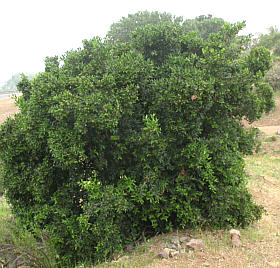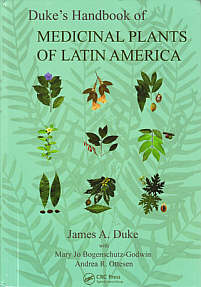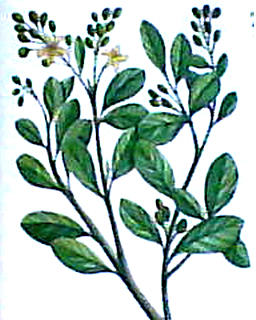|
Liver / Gallbladder Conditions / Indigestion
Anti-inflammatory / Neuroprotective / Vermifuge
Boldo

Boldo
(Peumus boldus Molina)
Code BOS218
Price: $14.50
120 Capsules x 500 mg.
Order Now
 Email
Email
 Summarized Description: Summarized Description:
Boldo is the sole species of the Peumus genus, native to the
scherophyll forests
in Chile in the southern latitude of 33º to 40º. Its leaves are
used throughout South America as an herbal tea, and its fruit is edible.
It's most active medicinal agent is "boldine."
Uses & Protocols
 Its most common use in herbal medicine is to treat dyspepsia, gallstones,
and gallbladder inflammation, but it is also used for its
choleretic and
cholagogue properties.
Recommended dosage: one to two capsules, twice daily.
Warnings & Contraindications
 Boldo should not be used when there is a serious
liver condition, or obstruction of the bile duct. We do not recommend for long term
consumption, as hallucinations at higher dosages over longer periods have been
reported (PH2). Moreover, there is one report of "hallucinations" in one 12-year old subject
(see second PubMed study, cited in the right column), such that we do not recommend using
Boldo for those under the age of 14.
 Do not take if you are pregnant,
attempting to conceive, or lactating.
Because Boldo has mild blood-thinning properties, it is contraindicated for those
taking blood-thinning medication. Taylor notes that Boldo "may decrease the effect
or reduce the half-life of certain drugs that should be metabolized in the liver,"
so write to us if you have any questions about drug contraindications.
Shelf-Life
 Five years or more.

Medicinal Activities
 Further information for practitioners: Further information for practitioners:
World-famous botanist Dr. James Duke attributes the following activities
to this plant (p. 519-521; see hardcopy cover at right,
purchasable on Amazon),
drawn from the extant literature. (See his graduation for "level of
efficacy" on our amazon traditionals page;
followed by Duke's bibliographic abbreviations (in capital letters),
which we identify
on a separate page.)
 Duke provides a " food farmacy potential" score for this
plant of "FNFF=!."
- Abortifacient (1;RAI)
- Analgesic (f; BGB; CRC; RAI)
- Anesthetic (f; VAD)
- Anthelmintic (1; BGB; EFS; GAZ)
- Antiaggregant (f1; RAI; X11310527)
- Anticholinergic (1; BRU)
- Antidiabetic (1; X10987997)
- Antihemolytic (1; X10925398)
- Antihistaminic (1; FNF; X12747739)
- Antiinflammatory (1; APA; MPG; RAI)
- Antimutagenic (1; X11265593)
- Antioxidant (1; APA; BGB; RAI; X12747739)
- Antiperoxidant (1; X12747739)
- Antiprostaglandin (1; BGB)
- Antiradicular (1; X12747739)
- Antirheumatic (f; EFS)
- Antiseptic (f1; CAN; CRC; EFS)
- Antipasmodic (12; APA; BRU; KOM; PH2; RAI; SHT)
- Antiulcer (1; FNF; X12747739)
- Aperitive (1; VAD)
- Bactericide (1; MPG)
- Calcium-Channel Blocker (1; X12044805)
- Candidicide (1; MPG)
- Carcinogenic (1; CRC)
- Cardiodepressant (1; RAI)
- Carminative (f1; BGB; RAI)
- Cholagogue (2; APA; CAN; SHT)
- Cholekinetic (2; SHT)
- Choleretic (f12; CRC; HHB; KOM; PH2; RAI; SHT)
- Coloprotective (1; RAI)
- Convulsant (1; VAD)
- Decongestant (f; RAI)
- Demulcent (f; CAN)
- Depurative (f; RAI)
- Detoxicant (f1; RAI; X11265593)
- Digestive (f1; RAI; VAD; X12747739)
- Diuretic (1; APA; BGB; CAN; RAI)
- Emetic (1; HHB)
- Febrifuge (1; RAI)
- Fungicide (1; MPG; VAD)
- Gastrostimulant (1; APA; KOM; PH2)
- Glutathiogenic (1; X11265593)
- Hepatoprotective (1; APA; BGB; BIS; RAI)
- Hepatotonic (f12; CAN; EFS; PNC)
- Hepatotoxic (1; X15764158)
- Hypnotic (f1; BIS; CRC; HHB; VAD)
- Hypouricemic (1; RAI)
- Laxative (f1; APA; HHB; RAI; VAD)
- Myorelaxant (1; APA; BGB; BRU; RAI)
- Narcotic (f1; EFS; VAD)
- Nervine (f; BGB)
- Neurotoxic (1; GAZ)
- NO-Inhibitor (1; X10987997)
- Orexigenic (2; PHR)
- Paralytic (1; RAI)
- Parasiticide (f1; RAI)
- Poison (f; CRC)
- Secretagogue (1; BRU; KOM)
- Sedative (f1; APA; CAN; EFS; HHB; VAD)
- Sialagogue (f; RAI)
- Stimulant (f; CRC; RAI)
- Stomachic (f1; CAN; HHB)
- Tonic (f; CRC; EFS; RAI)
- Uricosuric (1; BIS)
- Urinary Antiseptic (1; BOW; CAN; RAI)
- Uterorelaxant (1; RAI)
- Vasoconstrictor (1; X12044805)
- Vasorelaxant (1; RAI)
- Vermifuge (f1; CRC; HHB; RAI)
- Xantine-Oxidase-Inhibitor (1; MPG)
Indications
 Further information for practitioners: Further information for practitioners:
Duke provides the following indications for this plant:
- Aging (1; APA)
- Anorexia (f12; PHR; RAI)
- Arthrosis (f; EFS)
- Atherosclerosis (1; APA)
- Autoinmune Disease (1; APA)
- Bacteria (1; MPG)
- Biliousness (2; APA; CAN; SHT)
- Cancer (1; APA)
- Candida (1; MPG)
- Cardiopathy (f; RAI)
- Colechocystosis (f; BGB; HHB; RAI)
- Cholecystalgia (f; CAN)
- Cholelithiasis (1; CAN; HHB; VAD)
- Colds (f; CRC; RAI)
- Colitis (1; RAI)
- Constipation (f1; RAI; VAD)
- Coughs (f; CRC; RAI)
- Cramps (f12; APA; BRU; KOM; RAI; SHT)
- Cystosis (f1; BGB; CAN; PNC; RAI; VAD)
- Debility (f; RAI)
- Diabetes (1; X10987997)
- Diarrhea (f; RAI)
- Dislocations (f; MPG)
- Dropsy (f; MPG)
- Dyskenesia (1; VAD)
- Dyspepsia (f12; APA; BGB; BRU; KOM; PH2; RAI)
- Dyspnea (f; RAI)
- Earache (f; CRC; MPG; RAI)
- Edema (f; RAI)
- Enterosis (f12; APA; BOW; KOM; RAI)
- Escherichia (1; MPG)
- Fever (1; RAI)
- Fungus (1; MPG)
- Gallstones (1; BOW; CAN; HHB; PNC; RAI)
- Gas (f1; BGB; RAI)
- Gastrosis (f12; CRC; KOM; RAI)
- Gonorrhea (1; CAN; GMH; HHB; RAI)
- Gout (f1; APA; BGB; CRC; MPG; RAI)
- Head Colds (f; CRC; RAI)
- Heartburn (f; BGB; BRU)
- Hepatalgia (f; CAN)
- Hepatosis (f12; APA; CRC; HHB; PHR; RAI; X12747739)
- High Cholesterol (f; RAI)
- Hyperglycemia (1; X10987997)
- Hypertonia (2; KOM)
- Hypothyroidism (f; RAI)
- Inappetence (2; PHR)
- Infection (1; CAN; CRC; EFS)
- Inflammation (1; APA)
- Insomnia (f; APA; CAN; EFS; RAI)
- Kidney Stones (f; RAI)
- Jaundice (f; CRC; GMH; RAI)
- Lethargy (f; EFS)
- Malaria (1; FNF; RAI)
- Migraine (f; VAD)
- Mycosis (1; MPG)
- Nephrosis (f; BGB)
- Neuralgia (f; MPG)
- Obesity (f; BOW; PNC)
- Oliguria (f1; RAI)
- Pain (f; BGB; RAI)
- Parasites (1; BOW)
- Prostasis (f; BGB)
- Pseudomonas (1; MPG)
- Rheumatism (f; APA; BGB; CAN; EFS; MPG; RAI)
- Stomachache (f1; APA; RAI)
- Stones (1; BRU; VAD)
- Syphilis (f; CRC; HHB; RAI)
- Urethrosis (f; RAI)
- Urogenitosis (f; GMH; RAI)
- UTIs (1; BOW)
- VD (f; CRC; HHB; RAI)
- Vertigo (f; RAI)
- Water Retention (1; APA; BGB; CAN)
- Worms (f1; APA; CRC; EFS)
- Wounds (f; CRC)
- Yeast (1; MPG)
|
 To U.S. Users: To U.S. Users: This product
have not been evaluated by the U.S. Food & Drug Administration.
It is not intended to diagnose, treat, cure, or prevent any disease.
|
 Recent Studies on Boldo
Recent Studies on Boldo
Sourced from PubMed
 Disclaimer: Disclaimer: The following citations provide findings on the
properties of Boldo and offer insights into prospective areas of future research.
These findings should not be inferred to provide the basis of medicinal claims,
nor should they be relied upon by the public, as such. Readers who want full access to
the PubMed database are encouraged to
register with NCBI.
 As of Jan. 2017, there were
71 citations on PubMed for Boldo. Below are list a few of the more notable:
-
Neuroinflammatory response to experimental stroke is inhibited by boldine.
[ABSTRACT: . . . Although various mechanisms such as its antioxidant activity should be considered,
these results suggest that the neuroprotective effect of boldine might be related in part to its
anti-inflammatory properties.]
-
[Behavioural impairments and hallucinations after consumption of boldo leaf infusions].
[ABSTRACT: We report a case of behavioural impairments with hallucinations in a twelve-year-old girl,
after consumption of boldo leaf infusions. The main alkaloid of boldo, named boldine, is very likely
responsible for temporary neuropsychiatric disturbances present in the patient. The emergence of behavioural problems
and hallucinations without any obvious cause, should lead to search for consumption of boldo leaf infusion ("tisanes").
This consumption must be avoided in children.]
-
Evaluation of cytotoxic and chemotherapeutic properties of boldine in breast cancer using in vitro and in vivo models.
[ABSTRACT: To date, plants have been the major source of anticancer drugs. Boldine is a natural alkaloid commonly found in the leaves
and bark of Peumus boldus. In this study, we found that boldine potently inhibited the viability of the human invasive breast cancer cell lines,
MDA-MB-231 (48-hour IC 46.5±3.1 μg/mL) and MDA-MB-468 (48-hour IC 50.8±2.7 μg/mL). Boldine had a cytotoxic effect and induced apoptosis
in breast cancer cells as indicated by a higher amount of lactate dehydrogenase released, membrane permeability, and DNA fragmentation.
In addition, we demonstrated that boldine induced cell cycle arrest at G2/M phase. The anticancer mechanism is associated with disruption of the
mitochondrial membrane potential and release of cytochrome c in MDA-MB-231. Boldine selectively induced activation of caspase-9 and caspase-3/7,
but not caspase-8. We also found that boldine could inhibit nuclear factor kappa B activation, a key molecule in tumor progression and metastasis.
In addition, protein array and Western blotting analysis showed that treatment with boldine resulted in downregulation of Bcl-2 and heat shock protein
70 and upregulation of Bax in the MDA-MB-231 cell line. An acute toxicity study in rats revealed that boldine at a dose of 100 mg/kg body weight was
well tolerated. Moreover, intraperitoneal injection of boldine (50 or 100 mg/kg) significantly reduced tumor size in an animal model of breast cancer.
Our results suggest that boldine is a potentially useful agent for the treatment of breast cancer.

-
Boldine protects endothelial function in hyperglycemia-induced oxidative stress through an antioxidant mechanism.
-
Anthelmintic effects of phytogenic feed additives in Ascaris suum inoculated pigs.
[ABSTRACT: Two experiments were performed to determine the anthelmintic effect of some phytogenic feed additives
on a mild infection of Ascaris suum in growing and finishing pigs. Usually, an infection of A. suum is controlled by using conventional
synthetic drugs. Organic farmers, however, prefer a non-pharmaceutical approach to worm control. Therefore, phytotherapy could be an
appropriate alternative. In the first experiment, a commercial available organic starter diet was supplemented with 3% of a herb mixture,
adding 1% Thymus vulgaris, 1% Melissa officinalis and 1% Echinacea purpurea to the diet, or with 4% of a herb mixture, thereby adding
the mentioned herbs plus 1% Camellia sinensis (black tea). A negative control group (no treatment) and a positive control group (treatment
with conventional synthetic drug flubendazole) were included. In the second experiment, the anthelmintic properties against A. suum of three
individual herbs, Carica papaya, Peumus boldus and Artemisia vulgaris, each in a dose of 1%, were tested. Pigs were infected with 1000 infective
worm eggs each. Each experiment was performed with 32 individually housed growing pigs (8 replicates/treatment), which were monitored for 67 days.
It was hypothesized that the herbs would block the cycles of the larvae, thereby preventing the development of adult worms. Therefore, phytogenic
feed additives were not supplied during the whole experimental period, but only from the start until D39. Pigs were inoculated with infective worm
eggs during five consecutive days (D17-D21). At D67 all pigs were dissected, whereafter livers were checked for the presence of white spots.
Also numbers of worms in the small intestine were counted. In experiment 1, the numbers of worm-infected pigs were similar for both the herb
supplemented (groups 3 and 4) and the unsupplemented (group 1) treatments (5-6 pigs of 8), while the treatment with flubendazole (group 2)
resulted in 0 infected pigs. In experiment 2, herb addition (groups 2-4) did not significantly reduce the number of worm-infected pigs compared
to the negative control (group 1). It can be concluded that the tested herb mixtures and individual herbs in the diets of growing and finishing pigs
did not decrease the number of pigs which were infected with A. suum, although the herb mixture without black tea and also boldo leaf slightly
(P<0.10) reduced the number of worms in the intestinal tract. The tested herb mixtures and individual herbs did not affect the performance of the pigs.

 Extensive information about
Boldo is covered on the Raintree Forest website.
Even better, you can purchase Leslie Taylor's excellent reference book,
The Healing Power
of Rainforest Herbs: A Guide to Understanding and Using Herbal Medicinals at Amazon.
 Also, see
Wikipedia article on Boldo.
|


 Recent Studies on Boldo
Recent Studies on Boldo

